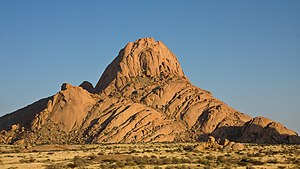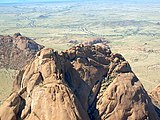Spitzkoppe
| Spitzkoppe | ||
|---|---|---|
|
Spitzkoppe |
||
| height | 1728 m | |
| location | Namibia , Southern Africa | |
| Mountains | Erongo | |
| Coordinates | 21 ° 49 ′ 29 " S , 15 ° 11 ′ 39" E | |
|
|
||
| Type | Inselberg, volcanic origin | |
| rock | granite | |
| Age of the rock | 100 million years | |
| First ascent | November 13, 1946 | |
The Spitzkoppe (also Spitzkuppe , Spitzkopje or Spitskopje ) is an island mountain with 1728 m height 120 km east of Swakopmund in Namibia , which towers over its surroundings 700 meters. Due to its distinctive shape, it is also known as the “Matterhorn of Namibia” and is one of the most photographed mountains in the country.
Location and description
In addition to the main peak ( Große Spitzkoppe ) there is a peak to the west with 1584 m ( 21 ° 49 ′ S , 15 ° 10 ′ E ). Still belong to the mountain group
- the Kleine Spitzkoppe ( 1557 m , 21 ° 51 ′ S , 15 ° 3 ′ E )
- and the Schwarze Spitzkoppe ( 1178 m , 21 ° 40 ′ S , 15 ° 8 ′ E )
The protection force for German South West Africa maintained a police station on the Spitzkoppe .
In 2011 the Spitzkoppe was proclaimed a national monument , which was not extended.
Geology and vegetation
The Spitzkoppe was created by an intrusion which, however, did not reach the surface of the earth. Over the course of millions of years, the surrounding cover rock weathered and only the more weather-resistant granite of the intrusion remained. The area around the Great Spitzkoppe is world famous for its pegmatite minerals, especially topaz .
The vegetation, especially butter tree , balsam tree , Boscia albitrunca , desert kohlrabi and euphorbia , is more abundant here than in the surrounding area, as the clouds here often rain down.
Touristic
As on the Brandberg and in Twyfelfontein, there are rock paintings that are thousands of years old , the most famous site is the Bushman's Paradise . However, these paintings have been largely destroyed by vandalism. There is also the rhino wall , which shows that they must have lived here in the past. Most of the rock paintings are only accessible with a guide from residents of the communal village community, which can easily be organized at the entrance to the national monument.
The bizarre rock formations are a popular and challenging destination for climbers. Climbing is almost impossible in summer as the rocks get too hot in the sun. Contrary to all appearances, climbing the summit is difficult (according to the UIAA scale V + on the easiest route), the first ascent took place in 1946. Since then the summit has been reached by around 600 rope teams . There are now around 200 climbing routes, some of them very difficult, in the area. A wild fence that was left over from the filming of the film 10,000 BC has closed off half of all camping sites for about 3 years, as has a large part of the climbing routes, including access to the popular normal route to the Great Spitzkoppe. The number of climbs therefore fell from around 80 to only around 10 per year. There are a number of bouldering opportunities around the Spitzkoppe .
In addition to the Spitzkoppe, a stone arch is one of the main attractions of the area.
Among the most common gemstone - minerals in the field of Spitzkoppe include topaz , rose quartz and various tourmalines .
Other Spitzkoppen in Namibia
Other mountains in Namibia that are named Spitzkoppe are:
- Spitzkoppe 21 ° 54 ′ S , 17 ° 33 ′ E
- Spitzkoppe North 27 ° 18 ′ S , 15 ° 41 ′ E
- Spitzkoppe 26 ° 25 ′ S , 18 ° 29 ′ E
literature
- Annie Symonds: Spitzkoppe. The Whole Story. NACOBTA, Windhoek
Web links
- Official website of the National Monument of the Spitzkoppe (English)
- Pictures from the Spitzkoppe
- Pictures of the Spitzkoppe and the rock carvings
- Minerals
References and comments
- ^ Location of the Great Spitzkoppe ( Groot Spitskopje, Groot Spitzkopje, Gross Spitzkoppe ), Spitzkopje Area, Karibib, Erongo Region, Namibia. In: mindat.org. Hudson Institute of Mineralogy, accessed August 19, 2019 .
- ↑ Spitzkoppe climbing area in Namibia. Retrieved January 14, 2020 .
- ↑ As of March 2009
- ^ Eckhardt Haber: Spitzkoppe & Pontoks , Blue Mountains Publishers, 2001, 99 pages, ISBN 0-620-27337-2
- ^ Spitzkoppe - Inselberg in the Erongo region of Namibia. Retrieved January 14, 2020 .




